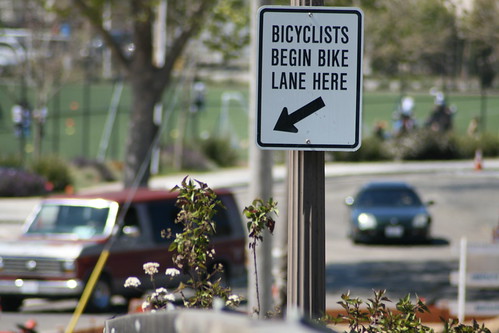California Jerry Brown yesterday signed AB 417, Assembly Member Jim Frazier’s bill to exempt bicycle plans from provisions of the California Environmental Quality Act (CEQA).

Background
In June 2005, San Francisco adopted its Bicycle Plan, a five year plan to fund and implement various improvements to bicycle facilities in the city. Transportation staffers determined that the plan was exempt from the CEQA based upon their finding that there was no possibility that the bicycle plan would have significant impacts on the environment.
Rob Anderson and other petitioners famously sued the city to slow or halt implementation of the plan, claiming the bike plan could have significant environmental impacts. The court immediately enjoined the city from implementing its plan and, in 2007, ruled an environment impact report (EIR) is necessary for the plan to move forward. The city prepared and certified the EIR for the bike plan in 2009 and they’ve been going gangbusters on new bike facilities ever since. You can read the details of that legal saga here.
The lawsuit had a chilling effect on the creation and implementation of local bike plans statewide. Frazier introduced AB 417 to remove what some observors believe is an abuse of the environmental review process.
AB 417, which is among the bills in the California Bicycle Coalition list of important bicycle legislation, exempts a bicycle transportation plan in an urbanized area from CEQA review. AB 417 also exempts agencies from preparing a traffic and safety impact assessment for certain bike lane projects. The law will sunset in 2018.
Requiring an INDEPENDENT engineering review would, however, help weed out a lot of the ill-conceived tripe that pass for bike facilities nowadays. AASHTO doesn’t seem to be enough by itself.
Alas, AB 417, a re-run of last year’s failed SB 1380, is a dud. It was introduced with SB 1380’s mistaken (b)(2) subsection — it stipulated that your bike plan can be exempt from CEQA as long as you
Include measures in the bicycle transportation plan to mitigate potential vehicular traffic impacts and bicycle and pedestrian safety impacts.
which is wrong — if it’s really a CEQA exemption then there shouldn’t be any “mitigate” language, mandatory or recommended. “Exempt” means exempt, hold public meetings (the other requirement for invoking the AB 417 exemption) and go directly to bikeway implementation. Helpful citizens recommended striking that (b)(2) subsection to make the measure a proper exemption, or at least swapping “address” for “mitigate”, but instead the Senate Natural Resources Committee fouled it up further:
Prepare an assessment of any traffic and safety impacts of the project and include measures in the bicycle transportation plan to mitigate potential vehicular traffic impacts and bicycle and pedestrian safety impacts.
And that’s what the governor signed. So under AB 417 your CEQA-exempt bike plan can go forward and all you need is some public review and an assessment of traffic impacts (i.e. intersection LOS and other automobility metrics) and measures to mitigate vehicular traffic impacts (i.e. keep cars moving freely by compromising the plan’s bicycle circulation improvements). Oops, that’s no help.
And worse, AB 417 reached back to last year’s AB 2245, a project-level version of the CEQA exemption, and added more nonsense to PRC 21080.20.5 about being excused from preparation of a traffic impact assessment if your project had a traffic impact assessment + mitigations properly prepared and adopted within the past five years. Oops, it was useless and now it’s worse.
I’m grateful to Assemblymember Frazier and his staff for their work in moving this bill through the legislature and to the governor’s desk, and deeply appreciate the impulse to liberate routine bicycle transportation from CEQA’s counterproductive barriers to nurturing sustainable transportation. We’ll try again next year from a fresh direction . . .
Urk, that’s a brick of a comment, please cross your eyes as you read it . . .
For those of us who live out in suburgatory, that sort of language might not be the show-stopper you think it is. For example, we just had a road diet held up for 6 months here because, despite all of the traffic modelers’ predictions to the contrary, residents thought bike lanes would get in the way of their cars. Under the “mitigate negative impacts to traffic” language, they wouldn’t have a leg to stand on– there aren’t any negative impacts to traffic, just angry NIMBYs.